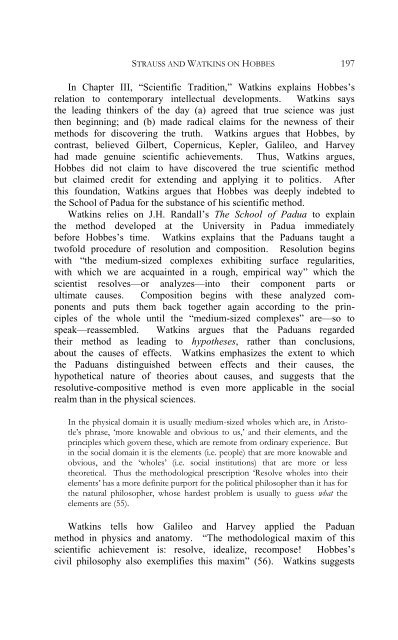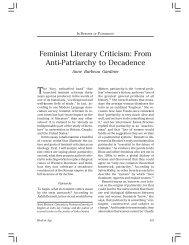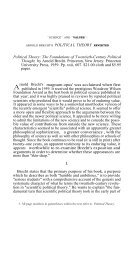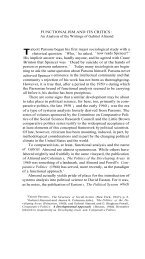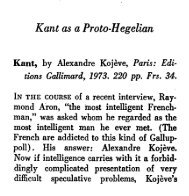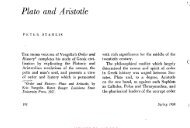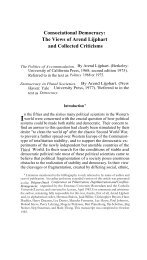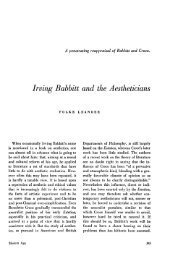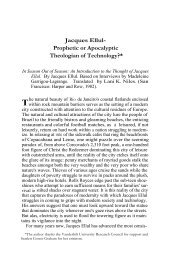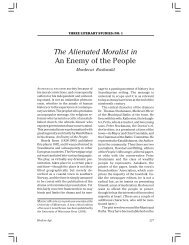Strauss and Watkins on Hobbes' Political Philosophy: A Review
Strauss and Watkins on Hobbes' Political Philosophy: A Review
Strauss and Watkins on Hobbes' Political Philosophy: A Review
You also want an ePaper? Increase the reach of your titles
YUMPU automatically turns print PDFs into web optimized ePapers that Google loves.
STRAUSS AND WATKINS ON HOBBES 197<br />
In Chapter III, “Scientific Traditi<strong>on</strong>,” <str<strong>on</strong>g>Watkins</str<strong>on</strong>g> explains Hobbes’s<br />
relati<strong>on</strong> to c<strong>on</strong>temporary intellectual developments. <str<strong>on</strong>g>Watkins</str<strong>on</strong>g> says<br />
the leading thinkers of the day (a) agreed that true science was just<br />
then beginning; <str<strong>on</strong>g>and</str<strong>on</strong>g> (b) made radical claims for the newness of their<br />
methods for discovering the truth. <str<strong>on</strong>g>Watkins</str<strong>on</strong>g> argues that Hobbes, by<br />
c<strong>on</strong>trast, believed Gilbert, Copernicus, Kepler, Galileo, <str<strong>on</strong>g>and</str<strong>on</strong>g> Harvey<br />
had made genuine scientific achievements. Thus, <str<strong>on</strong>g>Watkins</str<strong>on</strong>g> argues,<br />
Hobbes did not claim to have discovered the true scientific method<br />
but claimed credit for extending <str<strong>on</strong>g>and</str<strong>on</strong>g> applying it to politics. After<br />
this foundati<strong>on</strong>, <str<strong>on</strong>g>Watkins</str<strong>on</strong>g> argues that Hobbes was deeply indebted to<br />
the School of Padua for the substance of his scientific method.<br />
<str<strong>on</strong>g>Watkins</str<strong>on</strong>g> relies <strong>on</strong> J.H. R<str<strong>on</strong>g>and</str<strong>on</strong>g>all’s The School of Padua to explain<br />
the method developed at the University in Padua immediately<br />
before Hobbes’s time. <str<strong>on</strong>g>Watkins</str<strong>on</strong>g> explains that the Paduans taught a<br />
twofold procedure of resoluti<strong>on</strong> <str<strong>on</strong>g>and</str<strong>on</strong>g> compositi<strong>on</strong>. Resoluti<strong>on</strong> begins<br />
with “the medium-sized complexes exhibiting surface regularities,<br />
with which we are acquainted in a rough, empirical way” which the<br />
scientist resolves—or analyzes—into their comp<strong>on</strong>ent parts or<br />
ultimate causes. Compositi<strong>on</strong> begins with these analyzed com-<br />
p<strong>on</strong>ents <str<strong>on</strong>g>and</str<strong>on</strong>g> puts them back together again according to the prin-<br />
ciples of the whole until the “medium-sized complexes” are—so to<br />
speak—reassembled. <str<strong>on</strong>g>Watkins</str<strong>on</strong>g> argues that the Paduans regarded<br />
their method as leading to hypotheses, rather than c<strong>on</strong>clusi<strong>on</strong>s,<br />
about the causes of effects. <str<strong>on</strong>g>Watkins</str<strong>on</strong>g> emphasizes the extent to which<br />
the Paduans distinguished between effects <str<strong>on</strong>g>and</str<strong>on</strong>g> their causes, the<br />
hypothetical nature of theories about causes, <str<strong>on</strong>g>and</str<strong>on</strong>g> suggests that the<br />
resolutive-compositive method is even more applicable in the social<br />
realm than in the physical sciences.<br />
In the physical domain it is usually medium-sized wholes which are, in Aristo-<br />
tle’s phrase, ‘more knowable <str<strong>on</strong>g>and</str<strong>on</strong>g> obvious to us,’ <str<strong>on</strong>g>and</str<strong>on</strong>g> their elements, <str<strong>on</strong>g>and</str<strong>on</strong>g> the<br />
principles which govern these, which are remote from ordinary experience. But<br />
in the social domain it is the elements (i.e. people) that are more knowable <str<strong>on</strong>g>and</str<strong>on</strong>g><br />
obvious, <str<strong>on</strong>g>and</str<strong>on</strong>g> the ‘wholes’ (i.e. social instituti<strong>on</strong>s) that are more or less<br />
theoretical. Thus the methodological prescripti<strong>on</strong> ‘Resolve wholes into their<br />
elements’ has a more definite purport for the political philosopher than it has for<br />
the natural philosopher, whose hardest problem is usually to guess what the<br />
elements are (55).<br />
<str<strong>on</strong>g>Watkins</str<strong>on</strong>g> tells how Galileo <str<strong>on</strong>g>and</str<strong>on</strong>g> Harvey applied the Paduan<br />
method in physics <str<strong>on</strong>g>and</str<strong>on</strong>g> anatomy. “The methodological maxim of this<br />
scientific achievement is: resolve, idealize, recompose! Hobbes’s<br />
civil philosophy also exemplifies this maxim” (56). <str<strong>on</strong>g>Watkins</str<strong>on</strong>g> suggests


